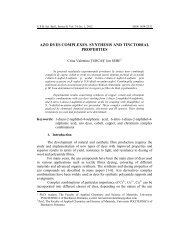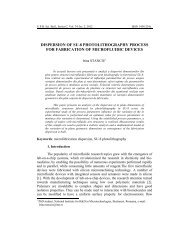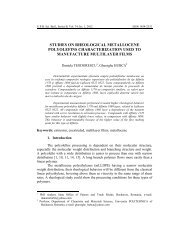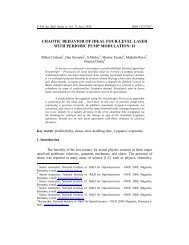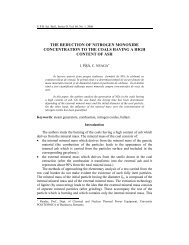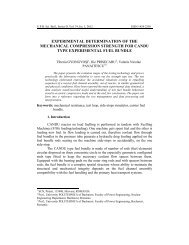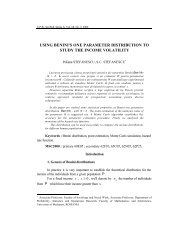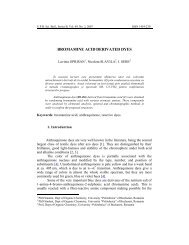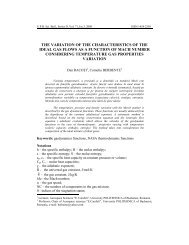poly bis-gma/ha based hybrid composite materials - Scientific Bulletin
poly bis-gma/ha based hybrid composite materials - Scientific Bulletin
poly bis-gma/ha based hybrid composite materials - Scientific Bulletin
You also want an ePaper? Increase the reach of your titles
YUMPU automatically turns print PDFs into web optimized ePapers that Google loves.
U.P.B. Sci. Bull., Series B, Vol. 73, Iss. 1, 2011 ISSN 1454-2331<br />
POLY BIS-GMA/HA BASED HYBRID COMPOSITE<br />
MATERIALS<br />
Maria FICAI 1 , Ecaterina ANDRONESCU 2 , Anton FICAI 3 ,<br />
Georgeta VOICU 4 , Bogdan Ştefan VASILE 5<br />
În această lucrare prezentăm sinteza şi caracterizarea unor nanocompozite<br />
hibride pe bază de of poli <strong>bis</strong>fenol A glicidil metacrilat şi hidroxiapatită (poli Bis-<br />
GMA/HA) pornind de la monomerul corespunzător şi pulbere de HA. Au fost<br />
propuse două metode de polimerizare: polimerizare termică şi respectiv chimică iar<br />
materialele rezultate au fost comparate, în special din punct de vedere al<br />
comportamentului termic. Procesul de polimerizare a fost complet doar în cazul<br />
polimerizării chimice. Materialele nanocompozite hibride au fost caracterizateprin<br />
XRD, FTIR, SEM şi TEM si se confirmă compoziţia şi morfologia materialelor.<br />
In this paper we present the synthesis and c<strong>ha</strong>racterization of <strong>poly</strong> <strong>bis</strong>phenol<br />
A glycidyl met<strong>ha</strong>crylate/hydroxyapatite (<strong>poly</strong> Bis-GMA/HA) <strong>hybrid</strong> nano<strong>composite</strong>s<br />
starting from the proper monomer and HA powder. Two <strong>poly</strong>merization methods<br />
were proposed: thermal and respectively chemical <strong>poly</strong>merization and the resulted<br />
<strong>materials</strong> were compared, especially from the point of view of thermal be<strong>ha</strong>viour.<br />
The <strong>poly</strong>merization process was completed only in the case of chemical<br />
<strong>poly</strong>merization. The <strong>hybrid</strong> nano<strong>composite</strong> <strong>materials</strong> were c<strong>ha</strong>racterized by XRD,<br />
FTIR, SEM and TEM t<strong>ha</strong>t confirm the composition and morphology of the <strong>materials</strong>.<br />
Keywords: <strong>hybrid</strong> <strong>composite</strong> <strong>materials</strong>, met<strong>ha</strong>crylate, hydroxyapatite, synthesis,<br />
c<strong>ha</strong>racterization<br />
1. Introduction<br />
Hydroxyapatite is one of the most used <strong>materials</strong> for <strong>ha</strong>rd tissue<br />
replacement because this is the main component of bones and teeth [1, 2].<br />
Hydroxyapatite (HA) is intensively used as pure ceramic [3], coatings [4] or<br />
<strong>composite</strong> <strong>materials</strong> such as: hydroxyapatite/gelatin nano<strong>composite</strong>s [5],<br />
1 Ph.D. student, eng., Faculty of Applied Chemistry and Materials Science, University<br />
POLITEHNICA of Buc<strong>ha</strong>rest, Romania, e-mail address: ficaimaria@yahoo.com<br />
2 Prof., Ph.D. eng., Faculty of Applied Chemistry and Materials Science, University<br />
POLITEHNICA of Buc<strong>ha</strong>rest, Romania<br />
3 Assistant, Ph.D. eng., Faculty of Applied Chemistry and Materials Science, University<br />
POLITEHNICA of Buc<strong>ha</strong>rest, Romania<br />
4 Lecturer, Ph.D. eng., Faculty of Applied Chemistry and Materials Science, University<br />
POLITEHNICA of Buc<strong>ha</strong>rest, Romania<br />
5 Ph.D. student, eng., Faculty of Applied Chemistry and Materials Science, University<br />
POLITEHNICA of Buc<strong>ha</strong>rest Romania
76 Maria Ficai, Ecaterina Andronescu, Anton Ficai, Georgeta Voicu, Bogdan Ştefan Vasile<br />
<strong>poly</strong>(lactide-co-glycolide)/ hydroxyapatite nano<strong>composite</strong>s [6], collagen/<br />
hydroxyapatite (nano)<strong>composite</strong>s [7], collagen- chitosan- hydroxyapatite<br />
nano<strong>composite</strong>s [8], <strong>poly</strong>(ethylene terepht<strong>ha</strong>late) / hydroxyapatite bio<strong>materials</strong> [9]<br />
etc.<br />
Bis-GMA (2,2-<strong>bis</strong>[p-(2'-hydroxy-3'-met<strong>ha</strong>cryloxypropoxy) phenyl]<br />
propane) is intensively used for dental application as filled or unfilled resins [10].<br />
In many cases, Bis-GMA is used in association with different inorganic<br />
biocompatible components such as: alumina [11, 12], zirconia [13], silica and<br />
silicates [14], titanium dioxide [15], calcium phosp<strong>ha</strong>tes [16], hydroxyapatite<br />
[17]. The desired properties of the <strong>composite</strong>s <strong>materials</strong> can be achieved by the<br />
proper choose of the composition and processing routes; usually Bis-GMA <strong>based</strong><br />
<strong>composite</strong> <strong>materials</strong> being obtained by chemical, photochemical or thermal curing<br />
[18-25].<br />
Only a few papers dealing with Bis-GMA/HA <strong>composite</strong> <strong>materials</strong> were<br />
published. Mostly, these <strong>composite</strong> <strong>materials</strong> are used for cementation, the<br />
obtained results being very promising [26].<br />
The purpose of the present work was to synthesize and c<strong>ha</strong>racterize <strong>poly</strong><br />
Bis-GMA/HA <strong>composite</strong> <strong>materials</strong> obtained by chemical and thermal<br />
<strong>poly</strong>merization of the Bis-GMA monomer. Also, an essential part of the present<br />
work was focussed on the study of differences induced by <strong>poly</strong>merisation<br />
methods, especially <strong>based</strong> on thermal be<strong>ha</strong>viour of the two kinds of <strong>materials</strong>.<br />
2. Materials and Methods<br />
Hybrid <strong>poly</strong>Bis-GMA/HA <strong>composite</strong> <strong>materials</strong> were obtained according to<br />
the procedure presented in Fig. 1. The <strong>poly</strong>merization of Bis-GMA was<br />
performed under chemical or thermal conditions. Benzoyl peroxide was used as<br />
initiator of the chemical <strong>poly</strong>merization of the monomer; the amount of benzoyl<br />
peroxide being of 0.5% (w/w) reported to the monomer. The thermal<br />
<strong>poly</strong>merization was done at 70 0 C for ~2 h. Both <strong>hybrid</strong> <strong>materials</strong> were obtained<br />
starting from Bis-GMA and HA, the ratio of the components being 1:9 (w/w). All<br />
reagents were used as received (Si<strong>gma</strong>-Aldrich) without any purification.<br />
X-ray diffraction analysis was performed using a Shimadzu XRD 6000<br />
diffractometer at room temperature, using Cu Kα radiation.<br />
Infrared spectroscopy (Shimadzu 8400 FT-IR Spectrometer) was<br />
performed in the range of 500 – 4000 cm -1 , with a resolution of 2 cm -1 .<br />
The differential thermal analysis (DTA) coupled with thermogravimetric<br />
analysis (TGA) was performed on a Shimadzu DTG-TA-50H, at a heating rate of<br />
10 0 C/min, in static air.
Poly <strong>bis</strong>-GMA/HA <strong>based</strong> <strong>hybrid</strong> <strong>composite</strong> <strong>materials</strong> 77<br />
SEM images were recorded on a HITACHI S2600N electron microscope.<br />
Prior to the analysis, all samples were covered with a layer of silver by plasma<br />
sputtering.<br />
TEM images were obtained on finely powdered samples using a Tecnai TM<br />
G 2 F30 S-TWIN high resolution transmission electron microscope (HRTEM)<br />
equipped with STEM – HAADF detector, EDX and EELS. The microscope was<br />
operated in transmission mode at 300kV while TEM point resolution was 2 Å and<br />
line resolution was 1 Å. The hydroxyapatite particles were assessed by selected<br />
area electron diffraction (SAED).<br />
Bis GMA<br />
Solubilization<br />
Homogenization of<br />
Bis GMA/HA<br />
Izopropanol<br />
evaporation<br />
Mixture of BisGMA and HA<br />
Thermal or chemical<br />
<strong>poly</strong>merization<br />
Composite <strong>poly</strong> Bis GMA/HA<br />
C<strong>ha</strong>racterization XRD, FTIR,<br />
DTA-TG, SEM, TEM<br />
* only if the <strong>poly</strong>merization occurs by chemical <strong>poly</strong>merization<br />
Izopropanol<br />
HA powder<br />
(benzoyl peroxide)*<br />
Fig. 1. Synthesis scheme of the <strong>hybrid</strong> <strong>poly</strong> Bis-GMA/HA <strong>composite</strong> <strong>materials</strong>
78 Maria Ficai, Ecaterina Andronescu, Anton Ficai, Georgeta Voicu, Bogdan Ştefan Vasile<br />
Results and discussion<br />
The <strong>hybrid</strong> <strong>composite</strong> <strong>materials</strong> were c<strong>ha</strong>racterized by X-ray diffraction –<br />
XRD, Fourier transform infrared spectroscopy – FTIR, scanning electron<br />
microscopy – SEM, transmission electron microscopy – TEM and complex<br />
thermal analysis DTA-TG-DTG.<br />
3.1 X–ray diffraction<br />
X–ray diffraction was used to analyze the crystalline p<strong>ha</strong>ses of the<br />
<strong>composite</strong>s <strong>materials</strong>.<br />
The most important peaks of the <strong>composite</strong> material are identified (Fig. 2).<br />
These belong to the HA ( 25.7; 28.9; 31.8; 32.06; 32.98; 35.95; 39.89; 46,66;<br />
49,29) and to the brushite (22,96; 26,64; 30,33; 34.2). The presence of brushite<br />
can be explained <strong>based</strong> on the reaction 1, phosp<strong>ha</strong>te anions being resulted by<br />
hydroxyapatite solubilisation and brushite formation is due to<br />
hydrogenophosp<strong>ha</strong>te precipitation. Based on the recorded diffractogram it can be<br />
observed a good crystallinity of the mineral p<strong>ha</strong>ses.<br />
PO + H O HPO +H O (1)<br />
I, CPS<br />
3 − + pKa3 = 12.67<br />
2−<br />
4 3 4 2<br />
1700<br />
1600<br />
1500<br />
1400<br />
1300<br />
1200<br />
1100<br />
1000<br />
<strong>poly</strong> Bis-GMA/HA, thermal <strong>poly</strong>merization<br />
<strong>poly</strong> Bis-GMA/HA, chemical <strong>poly</strong>merization<br />
HA, ASTM [74-5066]<br />
900<br />
800<br />
700<br />
600<br />
500<br />
400<br />
300<br />
200<br />
100<br />
0<br />
10 20 30 40 50 60 70<br />
2Theta<br />
HA<br />
CaHPO 4<br />
Fig. 2. X-Ray diffraction pattern of <strong>poly</strong> Bis-GMA/HA <strong>composite</strong> material obtained by thermal<br />
and respectively chemical <strong>poly</strong>merization
Poly <strong>bis</strong>-GMA/HA <strong>based</strong> <strong>hybrid</strong> <strong>composite</strong> <strong>materials</strong> 79<br />
3.2. Infrared spectroscopy<br />
Infrared spectroscopy is a useful tool of the <strong>composite</strong> material<br />
c<strong>ha</strong>racterization, because it can give information even for non-crystalline p<strong>ha</strong>ses<br />
of the <strong>composite</strong> material. The most intense absorption bands are t<strong>ha</strong>t belonging<br />
to the phosp<strong>ha</strong>te groups of HA: 567, 601 and 1035 cm -1 . The absorption bands of<br />
the <strong>poly</strong> Bis-GMA are 1250, 1292, 1409, 1511, 1635, 1725 and 2966 cm -1 . The<br />
broad absorption band from 3422 cm -1 belong to the associated HO groups from<br />
HA, <strong>poly</strong> Bis-GMA and isopropanol while the s<strong>ha</strong>rp band from 3569 cm -1<br />
correspond to the free hydroxyl groups of the above mentioned <strong>composite</strong>s. The<br />
low intensity of the absorption bands of <strong>poly</strong> Bis-GMA can be explained <strong>based</strong> on<br />
the mixing ratio between <strong>bis</strong>-GMA and HA.<br />
Absorbance<br />
5.5<br />
BisGMA-HA<br />
5.0<br />
4.5<br />
4.0<br />
3.5<br />
3.0<br />
2.5<br />
2.0<br />
1.5<br />
1.0<br />
0.5<br />
3569<br />
3422<br />
2966<br />
2378<br />
1725<br />
1635<br />
1511<br />
1409<br />
1292<br />
0.0<br />
4000<br />
3000<br />
2000<br />
Wavenumbers (cm-1)<br />
1000<br />
Fig. 3. Infrared spectrum of <strong>poly</strong> Bis-GMA/HA obtained by thermal <strong>poly</strong>merisation<br />
3.3. Scanning electron microscopy<br />
The scanning electron microscopy was used in order to visualize the<br />
morphology of the <strong>poly</strong> <strong>bis</strong>-GMA/HA <strong>composite</strong> material obtained by thermal<br />
<strong>poly</strong>merization. At low magnification (Fig. 4a, b), the SEM images prove the<br />
good homogeneity of the <strong>composite</strong> material whereas, the agglomerates and larger<br />
HA particles s<strong>ha</strong>pe and size can be studied at higher magnification (Fig. 4c).<br />
Hydroxyapatite particles form very irregular agglomerates from the point of view<br />
of s<strong>ha</strong>pe and size.<br />
1250<br />
1184<br />
1096<br />
1035<br />
967<br />
897<br />
632<br />
601<br />
567
80 Maria Ficai, Ecaterina Andronescu, Anton Ficai, Georgeta Voicu, Bogdan Ştefan Vasile<br />
Fig. 4. SEM images of <strong>poly</strong> Bis-GMA/HA <strong>composite</strong> material obtained by thermal <strong>poly</strong>merisation<br />
at 70 0 C<br />
3.4. Transmission electron microscopy<br />
TEM and HRTEM images were recorded in order to obtain higher<br />
magnification and to study the morphology of the agglomerates. Based on the<br />
TEM images, it can be seen t<strong>ha</strong>t the agglomerates are composed mainly by<br />
spherical, quasispherical and rod like particles. The rod like morphology is<br />
induced by the <strong>poly</strong>mer, due to the presence of –C6H4–CH2–C6H4– groups. TEM<br />
images are also a useful tool to determine the particles size. Based on the average<br />
size determined by SEM, the <strong>composite</strong> material can be considered as a true<br />
<strong>hybrid</strong> nano<strong>composite</strong>. At high resolution, the main crystallization planes of<br />
hydroxyapatite can be identified, for instance [210] and [211].
50nm<br />
Poly <strong>bis</strong>-GMA/HA <strong>based</strong> <strong>hybrid</strong> <strong>composite</strong> <strong>materials</strong> 81<br />
2nm<br />
100nm<br />
Fig. 5. TEM images of <strong>poly</strong> Bis-GMA/HA <strong>composite</strong> material obtained by thermal <strong>poly</strong>merisation<br />
at 70 0 C<br />
3.5. Thermal analysis<br />
The thermal be<strong>ha</strong>viour of the <strong>poly</strong> Bis-GMA <strong>composite</strong> <strong>materials</strong> is<br />
slightly influenced by the <strong>poly</strong>merization method. The use of benzoyl peroxide<br />
leads to a better <strong>poly</strong>merization of the Bis-GMA, which can be proved by the<br />
absence of the effect at 340 0 C (on DTA curve), but also by the absence of the<br />
peak (on DTG curve) at 210 0 C, respectively. The presence of these peaks is a<br />
proof t<strong>ha</strong>t Bis-GMA is left un<strong>poly</strong>merized and also partially <strong>poly</strong>merized Bis-<br />
GMA. The endothermic effect at 210 0 C, accompanied by a mass loss on TG curve<br />
corresponds to the degradation of the Bis-GMA. In both cases, the mass loss<br />
between ~200 and 450 0 C of about 10% correspond to the <strong>poly</strong>mer degradation.
82 Maria Ficai, Ecaterina Andronescu, Anton Ficai, Georgeta Voicu, Bogdan Ştefan Vasile<br />
DTA, uV<br />
DTA, uA<br />
a)<br />
b)<br />
250<br />
200<br />
150<br />
100<br />
50<br />
0<br />
-50<br />
200<br />
150<br />
100<br />
50<br />
0<br />
-50<br />
DTA (uV)<br />
TGA, (%)<br />
DrTGA (mg/sec)<br />
200 400 600 800<br />
86<br />
1000<br />
t, 0 C<br />
DTA (uV)<br />
TGA (%)<br />
DrTGA (mg/sec)<br />
200 400 600 800<br />
86<br />
1000<br />
TGA, DrTGA<br />
% mg/<br />
100 0.0005<br />
0 C<br />
98<br />
96<br />
94<br />
92<br />
90<br />
88<br />
98<br />
96<br />
94<br />
92<br />
90<br />
88<br />
0.0000<br />
-0.0005<br />
-0.0010<br />
-0.0015<br />
-0.0020<br />
-0.0025<br />
-0.0030<br />
-0.0035<br />
TGA DrTGA<br />
% mg/<br />
100 0.0005<br />
0 C<br />
0.0000<br />
-0.0005<br />
-0.0010<br />
-0.0015<br />
-0.0020<br />
-0.0025<br />
-0.0030<br />
t, 0 C<br />
Fig. 6. Complex thermal be<strong>ha</strong>viour of <strong>poly</strong> Bis-GMA/HA <strong>composite</strong> <strong>materials</strong> obtained by a)<br />
chemical and b) thermal <strong>poly</strong>merization
4. Conclusions<br />
Poly <strong>bis</strong>-GMA/HA <strong>based</strong> <strong>hybrid</strong> <strong>composite</strong> <strong>materials</strong> 83<br />
This paper presents two synthesis methods of <strong>poly</strong> Bis-GMA/HA <strong>hybrid</strong><br />
<strong>composite</strong> <strong>materials</strong> starting from Bis-GMA and HA powder. It can be concluded,<br />
the use of benzoyl peroxide improve the <strong>poly</strong>merization process of Bis-GMA,<br />
<strong>based</strong> on the complex thermal analysis.<br />
The TEM images showed t<strong>ha</strong>t the obtained <strong>hybrid</strong> <strong>materials</strong> are true<br />
nano<strong>composite</strong>, the <strong>poly</strong>mer <strong>ha</strong>ving rod-like morphology with 100-150 nm length<br />
and 15-25 nm diameter; the rod-like morphology being induced by the presence of<br />
the <strong>poly</strong> Bis-GMA.<br />
The obtained <strong>poly</strong> Bis-GMA/HA <strong>composite</strong> <strong>materials</strong> <strong>ha</strong>ve potential<br />
applications in orthopaedics and dentistry as filling or cementation <strong>materials</strong>.<br />
R E F E R E N C E S<br />
1. R.A. Field, M.L. Riley, F.C. Mello, M.H. Corbfidge, A.W. Kotula, Bone composition in cattle,<br />
pigs, sheeep, and poultry. Journal of Animal Science 1974;39(3):493-499<br />
2. D.A. Wahl, J.T. Czernuszka, Collagen-hydroxyapatite <strong>composite</strong>s for <strong>ha</strong>rd tissue repair.<br />
European Cells & Materials 2006;11:43-56<br />
3. A. Melinescu, M. Preda, L.E. Sima, S.M. Petrescu, I. Teoreanu, In vitro testing of<br />
hydroxyapatite bioceramics. Revista Romana De Materiale-Romanian Journal of Materials<br />
2008;38(3):233-236<br />
4. X.H. Z<strong>ha</strong>o, L.F. Yang, Y. Zuo, J.P. Xiong, Hydroxyapatite Coatings on Titanium Prepared by<br />
Electrodeposition in a Modified Simulated Body Fluid. Chinese Journal of Chemical<br />
Engineering 2009;17(4):667-671<br />
5. G.F. Zuo, C. Liu, H.L. Luo, F. He, H. Liang, J.H. Wang, et al., Synthesis of Intercalated<br />
Lamellar Hydroxyapatite/Gelatin Nano<strong>composite</strong> for Bone Substitute Application. Journal of<br />
Applied Polymer Science 2009 ;113(5):3089-3094<br />
6. P.B. Z<strong>ha</strong>ng, Z.K. Hong, T. Yu, X.S. Chen, X.B. Jing, In vivo mineralization and osteogenesis<br />
of nano<strong>composite</strong> scaffold of <strong>poly</strong> (lactide-co-glycolide) and hydroxyapatite surface-grafted<br />
with <strong>poly</strong>(L-lactide). Bio<strong>materials</strong> 2009;30(1):58-70<br />
7. A. Ficai, E. Andronescu, V. Trandafir, C. Ghitulica, G. Voicu, Collagen/hydroxyapatite<br />
<strong>composite</strong> obtained by electric field orientation. Materials Letters 2010; 64(4):541-544<br />
8. X.L. Wang, X.M. Wang, Y.F. Tan, B. Z<strong>ha</strong>ng, Z.W. Gu, X.D. Li, Synthesis and evaluation of<br />
collagen-chitosan-hydroxyapatite nano<strong>composite</strong>s for bone grafting. Journal of Biomedical<br />
Materials Research Part A 2009;89A(4):1079-1087<br />
9. P. Sirip<strong>ha</strong>nnon, P. Monvisade, Poly(ethylene terepht<strong>ha</strong>late)/hydroxyapatite bio<strong>materials</strong>:<br />
Preparation, c<strong>ha</strong>racterization, and in vitro bioactivity. Journal of Biomedical Materials<br />
Research Part A 2009;88A(2):464-469<br />
10. T. Hirose, K. Wakasa, M. Yamaki, A Visible-Light Activating Unit with Experimental Light-<br />
Conductors - Photo<strong>poly</strong>merization in Bis-Gma Unfilled Resins for Dental Application.<br />
Journal of Materials Science 1990;25(2A):932-935<br />
11. A. Sadan, M.B. Blatz, D. Soignet, Influence of silanization on early bond strength to<br />
sandblasted densely sintered alumina. Quintessence International 2003;34(3):172-176<br />
12. M. Kobayashi, S. Shinzato, K. Kawanabe, M. Neo, M. Matsushita, T. Kokubo, et al., Alumina<br />
powder/Bis-GMA <strong>composite</strong>: Effect of filler content on mec<strong>ha</strong>nical properties and<br />
osteoconductivity. Journal of Biomedical Materials Research 2000 ;49(3):319-327
84 Maria Ficai, Ecaterina Andronescu, Anton Ficai, Georgeta Voicu, Bogdan Ştefan Vasile<br />
13. J.P. Matinlinna, M. Heikkinen, M. Ozcan, L.V.J. Lassila, P.K. Vallittu, Evaluation of resin<br />
adhesion to zirconia ceramic using some organosilanes. Dental Materials 2006;22(9):824-831<br />
14. H.H.K. Xu, D.T. Smith, C.G. Simon, Strong and bioactive <strong>composite</strong>s containing nano-silicafused<br />
whiskers for bone repair. Bio<strong>materials</strong> 2004;25(19):4615-4626<br />
15. B. Yu, J.S. Ahn, J.I. Lim, Y.K. Lee. Influence of TiO2 nanoparticles on the optical properties of<br />
resin <strong>composite</strong>s. Dental Materials 2009;25(9):1142-1147<br />
16. D. Skrtic, J.M. Antonucci, E.D. Eanes, N. Eldelman, Dental <strong>composite</strong>s <strong>based</strong> on <strong>hybrid</strong> and<br />
surface-modified amorphous calcium phosp<strong>ha</strong>tes. Bio<strong>materials</strong> 2004;25(7-8):1141-1150<br />
17. J. Suwanprateeb, R. Sanngam, W. Suwanpreuk, Fabrication of bioactive hydroxyapatite/<strong>bis</strong>-<br />
GMA <strong>based</strong> <strong>composite</strong> via three dimensional printing. Journal of Materials Science-Materials<br />
in Medicine 2008;19(7):2637-2645<br />
18. H. Arikawa, H. Taka<strong>ha</strong>shi, T. Kanie, S. Ban, Effect of various visible light photoinitiators on<br />
the <strong>poly</strong>merization and color of light-activated resins, Dental Materials Journal<br />
2009;28(4):454-460<br />
19. E. Brambilla, M. Gagliani, A. Ionescu, L. Fadini, F. Garcia-Godoy, The influence of lightcuring<br />
time on the bacterial colonization of resin <strong>composite</strong> surfaces. Dental Materials<br />
2009;25(9):1067-1072<br />
20. R. De Santis, A. Gloria, H. Sano, E. Amendola, D. Prisco, F. Mangani, et al. Effect of light<br />
curing and dark reaction p<strong>ha</strong>ses on the thermomec<strong>ha</strong>nical properties of a Bis-GMA <strong>based</strong><br />
dental restorative material. Journal of Applied Bio<strong>materials</strong> & Biomec<strong>ha</strong>nics 2009;7(2):132-<br />
140<br />
21. F. Lopez-Suevos, S.H. Dickens, Degree of cure and fracture properties of experimental acidresin<br />
modified <strong>composite</strong>s under wet and dry conditions. Dental Materials 2008;24(6):778-<br />
785<br />
22. W.F. Schroeder, W.D. Cook, C.I.Vallo, Photo<strong>poly</strong>merization of N,N-dimethylaminobenzyl<br />
alcohol as amine co-initiator for light-cured dental resins. Dental Materials 2008;24(5):686-<br />
693<br />
23. J.W. Kim, L.U. Kim, C.K. Kim, B.H. Cho, O.Y.Kim, C<strong>ha</strong>racteristics of novel dental <strong>composite</strong>s<br />
containing 2,2-<strong>bis</strong>[4-(2-methoxy-3-met<strong>ha</strong>cryloyloxy propoxy) phenyl] propane as a base<br />
resin. Biomacromolecules 2006;7(1):154-160<br />
24. Y. Kim, J.Y. Lee, K.Y. Park, C.K. Kim, O.Y. Kim, C<strong>ha</strong>racteristics of dental restorative<br />
<strong>composite</strong> resins prepared from 2,2-<strong>bis</strong>-[4-(2-hydroxy-3-met<strong>ha</strong>cryloyloxy propoxy) phenyll<br />
propane derivatives and spiro orthocarbonate. Polymer-Korea 2004;28(5):426-432<br />
25. R.W. Arcis, A. Lopez-Macipe, M. Toledano, E. Osorio, R. Rodriguez-Clemente, J. Murtra, et<br />
al., Mec<strong>ha</strong>nical properties of visible light-cured resins reinforced with hydroxyapatite for<br />
dental restoration. Dental Materials 2002;18(1):49-57<br />
26. W.R. Walsh, M.J. Svehla, J. Russell, M. Salto, T. Nakashima, R.M. Gillies, et al., Cemented<br />
fixation with PMMA or <strong>bis</strong>-GMA resin hydroxyapatite cement: effect of implant surface<br />
roughness. Bio<strong>materials</strong> 2004;25(20):4929-4934.



